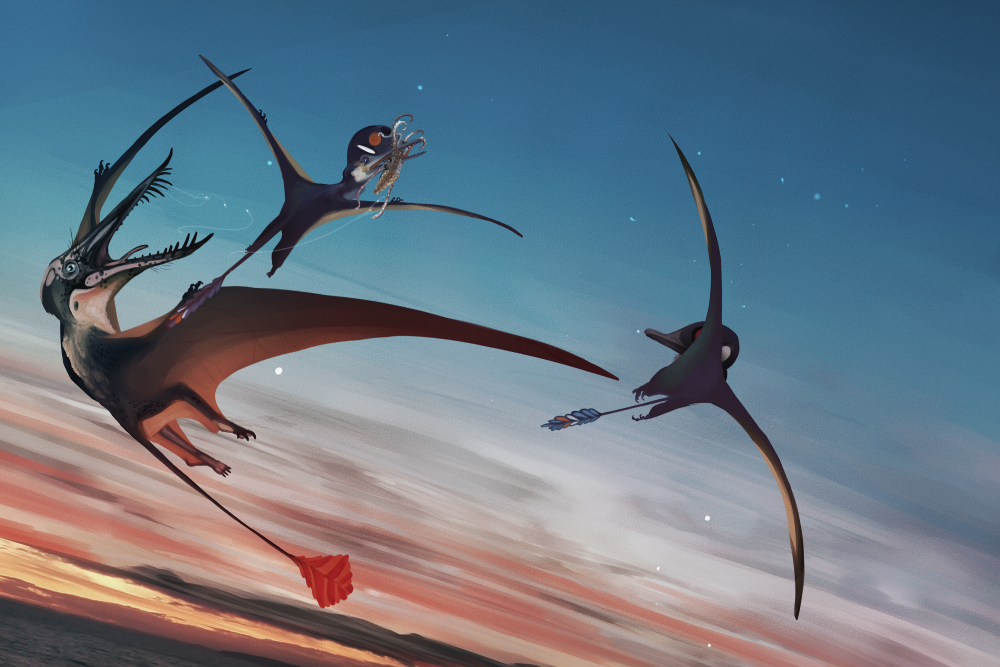Scientists studying one of the largest pterosaur fossils ever found and identified have concluded that these animals were likely more diverse in the Jurassic than the fossil record suggests. Armed with what they described as a “field-defining” discovery from the Isle of Skye, the species Dearc sgiathanach, they uncovered groundbreaking insights into their functional anatomy and evolutionary adaptations.
ADVERTISEMENT GO AD FREE
This remarkable specimen “alters the way we perceive pterosaur evolution, suggesting these flying reptiles reached notable sizes and diverse morphologies in advance of the Late Jurassic”, the authors write in their paper.
The fanged jaws of this 170-million-year-old Jurassic pterosaur were first spotted by PhD student Amelia Penny poking out of a rock on the Isle of Skye, Scotland, back in 2017. After battling tides with diamond-tipped saws to retrieve it, the team brought the fossil to the University of Edinburgh for study.
The name Dearc sgiathanach (pronounced jark ski-an-ach) is Scottish Gaelic and pays homage to the Isle of Skye where it was found, with the double meaning of “winged reptile” and “reptile from Skye”. As the largest pterosaur of the Jurassic period known to science, it’s expected to have had a wingspan over 2.5 meters (over 8.2 feet) – and yet, despite this massive size, scientists believe Dearc could’ve got much bigger.
Dearc is one of the large Jurassic pterosaurs that’s actually well preserved, we can look at its bone shape to infer how it was capable of flight despite its large size and how its anatomy changed to accommodate this.
Natalia Jagielska
A peek at the growth rings inside its bones revealed that it was a juvenile subadult and not yet fully grown when it died. What D. sgiathanach can tell us about pterosaurs in a broader sense is that these flying reptiles were reaching large sizes earlier than previously expected for this geological period.
It was once thought that pterosaurs were quite restricted in size from the Triassic through to the Jurassic, before supersizing in the Cretaceous alongside a diverse range of birds. Instead, Dearc supports the theory that pterosaurs were reaching larger body sizes and wingspans greater than 2 meters as early, if not earlier, as the Middle Jurassic (around 174–161 million years ago).
These flying reptiles had interlocking fangs that may have made it easier to grasp squid.
Image Credit: Illustration by Natalia Jagielska / N Jagielska et al 2025, BMC Ecology and Evolution
A closer look at the fossils using photography and X-ray microtomography revealed evidence of scarring from muscle attachments on the surface of the deltopectoral crest, suggesting Dearc had large pectoral muscles for flying and hunting. The research also identified a cluster of interlocking fangs, an adaptation that could’ve come in handy for snatching squid from the ocean.
It seems there was a mass diversification in pterosaur morphologies between the Lower and Middle Jurassic. As we adjust our thinking on pterosaur evolution, there could well be more well-preserved specimens to be found elsewhere in the world that could fill gaps in the fossil record.
“Pterosaurs were the largest vertebrates to achieve flight, with largest specimens in Cretaceous (almost 100 million years later than Dearc) taking to the skies,” the study’s first author, paleontologist Natalia Jagielska, told IFLScience. “Dearc is one of the large Jurassic Pterosaurs that’s actually well preserved, we can look at its bone shape to infer how it was capable of flight despite its large size and how its anatomy changed to accommodate this.”
“We discovered powerful depressions excavated by muscle attachments in its humerus, responsible for flight. Its neck also sported supportive structures to keep the large head in place.”
ADVERTISEMENT GO AD FREE
The continued examination of this remarkably preserved fossil continues to bring us closer to the true story of how pterosaurs took to the skies despite, in some cases, being as tall as a giraffe. Jagielska next hopes to study how their soft flight membranes behaved and evolved as part of her new research post at the Chinese University of Hong Kong.
A big week for pterosaur news, it seems, as another study recently described an incredibly rare: a neck bone of a young Azhdarchid with a bite mark. Who was behind the 76-million-year-old crime? We spoke to the scientists to find out.
The study is published in the journal BMC Ecology and Evolution.
Source Link: One Of The Largest Pterosaur Fossils Ever Found Is Rewriting Their Evolutionary History
